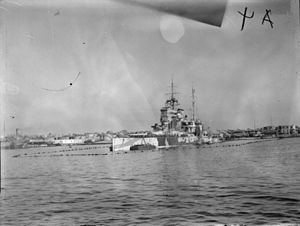Spartaco Schergat: Difference between revisions
No edit summary |
No edit summary |
||
| Line 18: | Line 18: | ||
Although the two capital ships sank only in a few feet of water and were eventually raised, they were out of action for over one year.<ref>"...the battleships Queen Elizabeth and Valiant, so badly damaged that they were effectively out of service for the duration of the Italian war effort." Sadkovich, page 334</ref> |
Although the two capital ships sank only in a few feet of water and were eventually raised, they were out of action for over one year.<ref>"...the battleships Queen Elizabeth and Valiant, so badly damaged that they were effectively out of service for the duration of the Italian war effort." Sadkovich, page 334</ref> |
||
This represented a dramatic change of fortunes against the Allies from the strategic point of view in the central Mediterranean during the next half-year. The Italian fleet had achieved [[naval supremacy]].<ref>"Consequently, the Alexandria Fleet remained for many months without any battleships, and it was forced to abandon any further open activity. In fact, Admiral Cunningham wrote that his Fleet now ''should have to leave it to the Royal Air Force to try if they could dispute the control of the Central Mediterranean with the enemy's fleet.''(...) In fact, it opened a period of clear Italian naval supremacy in the east-central Mediterranean." Bragadin, page 152</ref> |
This represented a dramatic change of fortunes against the Allies from the strategic point of view in the central Mediterranean during the next half-year or more. The Italian fleet -with the Alexandria Raid- had achieved [[naval supremacy]] in the Mediterranean sea, called in that year [[Italy's Mare Nostrum]] by fascist propaganda.<ref>"Consequently, the Alexandria Fleet remained for many months without any battleships, and it was forced to abandon any further open activity. In fact, Admiral Cunningham wrote that his Fleet now ''should have to leave it to the Royal Air Force to try if they could dispute the control of the Central Mediterranean with the enemy's fleet.''(...) In fact, it opened a period of clear Italian naval supremacy in the east-central Mediterranean." Bragadin, page 152</ref> |
||
==Notes== |
==Notes== |
||
| Line 34: | Line 34: | ||
* [[Istrian Italians]] |
* [[Istrian Italians]] |
||
* [[Luigi Durand de la Penne]] |
* [[Luigi Durand de la Penne]] |
||
* [[Italy's Mare Nostrum]] |
|||
Revision as of 23:47, 1 May 2010

Spartaco Schergat (1920, Capodistria -1996, Rome) was an Italian military frogman during WWII.
Biography
Schergat was born in Istria from an Italian irredentist and as a voluntary entered in the Royal Italian Navy in 1940. He was a friend of Luigi Durand de la Penne, who enrolled him in the elite Decima MAS (XMAS).
He is famous because sank -with a "maiale"- the English battleship Queen Elizabeth in 1941 during the Raid on Alexandria. For this military action he received the Italian gold medal in the Second World War[1]
After 1943 he collaborated with the Allies until the end of the war.
Sinking of the Queen Elizabeth
As part of a team of divers of the X MAS he took part in the human torpedo attacks on British vessels in the Mediterranean. In December 1941, he was one of a team of six (Luigi Durand de la Penne with Emilio Bianchi; Antonio Marceglia with Spartaco Schergat; Vincenzo Martellotta with Mario Marino) that attacked Alexandria harbour. They used the new Italian secret torpedo S.L.C. ("Siluro Lenta Corsa", also known as "maiale"), small underwater assault vehicle with a crew of two. As a result, four ships were sunk in Alexandria: the British battleships Queen Elizabeth (by Marceglia and Schergat) and Valiant (by Martellotta and Marino), and the oilship Sagona with the destroyer Jervis.
Spartaco Schergat placed personally the limpet mine under the hull of the Queen Elizabeth.
Although the two capital ships sank only in a few feet of water and were eventually raised, they were out of action for over one year.[2]
This represented a dramatic change of fortunes against the Allies from the strategic point of view in the central Mediterranean during the next half-year or more. The Italian fleet -with the Alexandria Raid- had achieved naval supremacy in the Mediterranean sea, called in that year Italy's Mare Nostrum by fascist propaganda.[3]
Notes
- ^ Article in Italian about the sinking of the battleship Queen Elizabeth.
- ^ "...the battleships Queen Elizabeth and Valiant, so badly damaged that they were effectively out of service for the duration of the Italian war effort." Sadkovich, page 334
- ^ "Consequently, the Alexandria Fleet remained for many months without any battleships, and it was forced to abandon any further open activity. In fact, Admiral Cunningham wrote that his Fleet now should have to leave it to the Royal Air Force to try if they could dispute the control of the Central Mediterranean with the enemy's fleet.(...) In fact, it opened a period of clear Italian naval supremacy in the east-central Mediterranean." Bragadin, page 152
Bibliography
- "Frogmen First Battles" by retired U.S Captain William Schofield's book. ISBN 0-8283-2088-8
- The Italian Navy in World War II by Marc'Antonio Bragadin, United States Naval Institute, Annapolis, 1957. ISBN 0-405-13031-7
- The Italian Navy during World War II by Sadkovich, James, Greenwood Press, Westport, 1994. ISBN 0-313-28797-X
